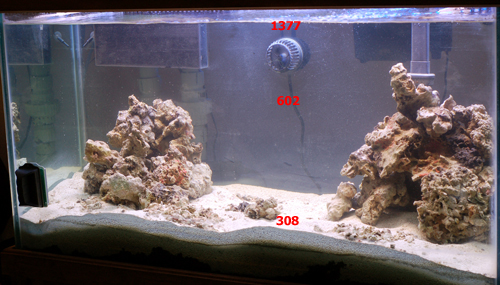I checked the link out and that is for nano tanks. There is a world of difference between a nano and a full size tank - even T5s struggle once you get past 20" in depth. You can light a nano reef completely under PC. That's an entirely different world.
When have you ever seen SPS and anemones kept under PC lighting? Never in the smallest of nanos have I seen this.
I suppose you glossed over the
75g build, the
60g build, and the
125 gallon build? I wouldn't qualify those as nanos...
Also Are you familiar with optics? They're focusing lenses made for LEDs. They concentrate the light output of the LEDs. Optics double the spread of the LEDs at half intensity. This is for lenses that spread light, but if you get narrow optics, ones narrower than the LEDs default spread, you get more concentrated light in a smaller area. So really, you can get narrow optics that will focus lighting down as deep as you want, theoretically... you will just need more LEDs for coverage. It gets cost prohibitive, but I never said that it didn't.
I am not judging based on one criteria, but several. Coverage, they tend to light straight down and there is a huge falloff of par once you get out from directly under them, which is a real problem on tanks 18-24" wide, even the PFO fixtures needed additional lighting for wider tanks; intensity is another factor as you say, the patent issue, and cost.
That's like saying MH isn't viable because it only lights up one spot... yeah, it does, so if you need more coverage, you add another pendant or get a fixture with better coverage.
No, there's no problem on wider tanks.. when you're making the fixture yourself, you can place as many LEDs in as many places as you need. That's one of the good things about DIY fixtures. With ones like the PFO you did need extra lighting, but in case you haven't noticed, they're out of business... if their design was that stellar, they would still be in business.
They do show promise, but I have seen other technologies come along in the hobby that show promise (halogen, mercury vapor) that never live up to their potential.
That's true. Only time will tell whether the benefits are proportionate to the extra cost... but for now, you cannot deny that at the very least they work and sustain corals and other inverts.
If you like PAR readings, let us see yours? You never see PAR readings and technical information out of LED manufacturers or owners, which makes me skeptical.
Are you familiar with how expensive PAR meters are? Terribly expensive.. I think low end models go for around $300. Most people who build LED fixtures, I conjecture, don't feel like spending hundreds of dollars extra to prove to the world what they already know themselves.
Let's say you just bought a brand new, 3x 400W MH fixture with T5HOs for actinic. It runs great and all your corals are happy and thriving... if this was the case, would you run out and buy a PAR meter so you could prove to the world that your fixture produced a certain PAR level? I would guess not... if there's nothing wrong with your corals, they're fine and growing, there's no need to quantify the light output. The same is true with LEDs.
I don't have PAR readings, but I don't really want or need them... I know after doing hundreds of hours of research that LEDs can support the most light demanding inverts we'd ever want to keep, and that's all I really need to know. If anyone reading this thread takes a peek at the previously liked thread to custom LED builds, they can learn in minutes that this is true.
Here is a picture of one build over a Biocube 14, with 11 LEDs (6 blues, 5 whites):
11 LEDs is a small amount for a tank that size and the creator didn't use optics. This is an example of what an average or middle of the road LED fixtures put out.
But the gist of what I say stands - if lighting a tank with LED costs 3-5x what a T5 or MH solution does without significantly better performance, its not a better solution.
Agreed, which is why I don't have one yet. But just because a solution doesn't work for you doesn't mean it won't work at all. The reason I don't have one yet is because of the price.. that doesn't mean that LEDs don't work.
Honestly, I would love to be nuts about LEDs too, I am no fan of the power company, and live in a hot state, but I just don't see the products after many years
I'm not trying to cram LEDs down your throat... you've already made it abundantly clear you don't like them, and I don't blame you.
If your argument is they're too expensive, then I agree. If your argument is the technology is too new to jump on-board, then I agree. If you argue that other solutions are better for you because of various circumstantial reasons, then I agree, LEDs are not for you... but I will not let you say they don't work when there are plenty of examples of them working.


